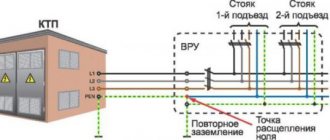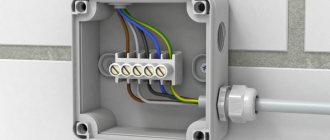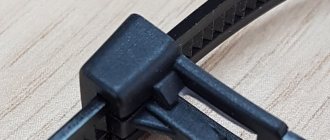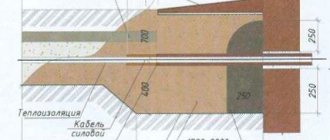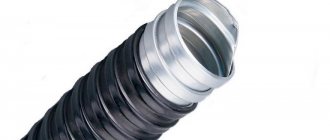Communication entry points are those places through which various engineering communications enter your building or private house from the outside. Communications inputs come in different diameters and for different engineering purposes:
- Sewerage
- Water supply
- Electricity
- Gas supply
- Heating
- Ventilation and air conditioning
If the openings through which communications enter buildings are located underground (in the basement or basement) or on the roof, balcony or open terrace, then this may be a potential threat of leaks. Places where pipes, cables, etc. They enter your building from the street - these are weak points through which water and moisture can subsequently penetrate into the room. This is why special attention should be paid to their correct installation and waterproofing.
Injection of communication inputs – Injection waterproofing
As mentioned earlier, injection of bushings is one of the most effective ways to protect this area from water, since injection compounds are supplied under pressure and have the ability to fill absolutely all voids and spaces. The injection essentially gets into the space between the concrete and the sleeve, casing, cable, pipe and fills it and possible voids and microcracks around it. Thus, injection compounds or materials block water and prevent it from penetrating into the room. Injection waterproofing is mainly used when builders did not pay due attention to the issue of sealing the entrance points of utility networks during construction, which ultimately led to the formation of leaks in the building.
You can read more about the injection method of waterproofing in the article – “Injection waterproofing”
Calculation of the volume of polyurethane foam for sealing pipes with cables
In almost every external cabling project, pipes are used to protect cables from mechanical damage. As you know, the ends of the pipes, after laying the cable, must be sealed. We will discuss what and how to compact in this topic.
Previously, I did not pay much attention to this topic. I included a standard solution in the project and everyone was happy with everything.
I added a standard sealing unit to the project, and in the notes I wrote that the sealing of the cables in the pipes should be made of jute intertwined cords coated with waterproof (crumpled) clay.
Typical cable seal in a pipe
I don’t have a very good idea of what kind of composition this is, and installers probably don’t like it, so I hear more and more often that polyurethane foam is used to seal pipes with cables.
Anyone who has worked with polyurethane foam knows very well how convenient it is to work with this material.
The problem is that the regulatory documents and standard solutions do not have clear instructions on the use of polyurethane foam.
In one of the documents (Arch. 1.105.03tm, updated edition) I found the following:
5 The pipe seal is made of jute intertwined cords coated with waterproof (crumpled) clay or other materials that do not allow moisture to pass through.
It turns out that we are being told that we can use other materials for compaction, not just cords with clay.
Is it possible to use regular foam for sealing?
I believe that if sealing is done in the ground, then regular polyurethane foam can be used for these purposes. There is no need to overpay for fire resistant foam. HDPE pipe is flammable, so what is the point of fire-resistant foam?
However, if we perform sealing when entering a building, then in this case the material must be non-flammable and ordinary polyurethane foam will not work.
This is confirmed in the standard project A11-2011 (Laying cables with voltages up to 35 kV in trenches using double-walled corrugated pipes):
Option for sealing the cable in a pipe when entering a building
Another question arises: how much foam should be included in the project?
To answer this question you need to know the internal diameter of the pipe and the diameter of the cable being laid.
Calculating the volume of foam is very simple, knowing the volume formula for a cylindrical body:
V=S*L,
where S is the internal area of the pipe,
L - seal length (200-300 mm).
Based on this formula, I created a simple calculator program that can clearly demonstrate the approximate volume of polyurethane foam for various pipes, as well as more accurately calculate for each case.
Calculation of the volume of polyurethane foam for sealing pipes with cables
This program will appear in the next 220soft newsletter, in a set of programs for EC.
If we take it very generally, then for small pipes (for example, lighting) I would put 0.5 liters per seal, and for power cables - 1.5 liters.
Are you experiencing difficulties when designing cable networks and outdoor lighting? I recommend “Practical course in designing cable networks 0.4/10 kV – All Inclusive”.
I recommend reading:
Calculation of the cost of projects EC, EV, EN, EP
Calculation of annual electricity consumption of a residential building
Internal power supply: calculation of short-circuit current when designing
Is it convenient to calculate voltage losses in moments?
Sealing of bushings prices and costs
Below are the average prices for work on sealing the entry points of various communications. Prices and cost of work vary depending on the diameter and list of work performed. The prices below do not take into account the cost of sealants or other materials used.
| Name of works | Inlet diameter | Unit | Price in rubles |
| Waterproofing of service entry points: – Installation of a technological fine – Surface preparation – Layer-by-layer compaction of expanding sealant | 50 | 1 PC | 24000 |
| 110 | 1 PC | 25000 | |
| 160 | 1 PC | 26000 | |
| Waterproofing of utility lines: – Installation of a process duct – Surface preparation – Installation of a bentonite profile – Layer-by-layer compaction of expanding sealant | 50 | 1 PC | 34000 |
| 110 | 1 PC | 37000 | |
| 160 | 1 PC | 39000 | |
| Waterproofing of communication inputs with the Stopaq system, including tying with an elastic profile and its sealing | 180 | 1 PC | 39000 |
| Sealing of communication inputs using the Injection method: – Joining the abutment seam / installing fines – Layer-by-layer compaction of repair composition – Marking injection centers, drilling holes (holes) – Installing packers (into holes) – Injection work using special equipment – Removing packers – Sealing injection centers with special composition | 50 | 1 PC | 69000 |
| 110 | 1 PC | 74000 | |
| 160 | 1 PC | 79000 |
Sealing of inputs price in estimate
The above prices do not take into account the complexity of the work and other factors that may affect the prices and the final cost of the work. If you want an accurate estimate with the final price per unit and the final cost taking into account the materials and work used, then you need to call a specialist or engineer from a company that specializes in waterproofing to inspect your facility. An experienced engineer, having familiarized himself with your facility and the specific situation with inlets and leaks, will be able to draw up a professional technical specification, which he will submit to the estimate department, which in turn will provide you with a detailed estimate, where you will see not only the final cost of the estimate, but also the prices for every position.
How and with what can cable passages be sealed and why?
Electrical laboratory » Questions and answers » How and with what can cable passages be sealed and why?
When constructing new buildings and structures, or when reconstructing old premises for various purposes, the projects must provide for the conditions and requirements for the placement of power supply communications in them. The main governing document is the PUE (electrical installation rules). The employees of our electrical laboratory are well aware of these requirements and have practically fulfilled them more than once. They constantly monitor changes in modern requirements, study additions, SNiPs, GOSTs and other regulations.
The documents detail the requirements, where and how, what cables and wires are laid. The requirements are described and take many factors into account:
- fire safety;
- operating conditions and location of buildings and structures;
- production sector in which electrical installations are involved;
- power and maximum current loads;
- types of wires and cables to be laid and many other details.
Basic requirements for cable passages through the wall
Paragraph 2.1.58 of the PUE states that in order to ensure the possibility of laying additional wiring or replacing the old one, cables and wires through the walls are laid in boxes or pipe cuttings. To prevent the penetration of fire or water, the gaps between the cable and the pipe are sealed with fire-resistant material, which can be easily removed if necessary. The fire resistance of the filler must be no lower than the fire-resistant properties of the wall in which
the cable passage
.
Sections of SNiP 3.05.06-85 clarify many individual details and expand the capabilities of performers; the content names specific materials used to seal cable passages.
In addition, it determines specific cases that through walls made of combustible material, pipes in passages must be metal or asbestos.
Examples of the composition and proportion of the sealing mass for sealing cable passages are given:
- 1:10 cement and sand;
- 1:3 clay and sand;
- 1.5:11:1 clay-sand and cement;
- 2:1 gypsum and expanded perlite, other options;
- Red foam with fire safety certificate.
Clearances between sleeves for cable passage
and the wall is sealed with cement mortar or concrete.
In cases where the walls are not a fire barrier, these gaps do not need to be sealed. When organizing cable passages through ceilings
and walls, provision must be made for laying backup pipes, metal, asbestos or plastic, depending on the conditions. In addition to pipe cuttings, industrially manufactured sleeves are used for transitions of cables and wires of different diameters through walls. Nuclear power plants use special sealed devices. These structures contain plates with grooves for different cable diameters.
Employees of construction companies or managers of organizations that operate buildings cannot always correctly navigate the implementation of many requirements. It is especially important to fulfill the requirements efficiently and at minimal cost, to choose the best option and materials for sealing gaps in cable passages, taking into account the conditions at your facility.
Thanks to extensive practical experience and knowledge, high-level technical support, the electrical laboratory
can conduct quality checks.
Our employees will tell you how, with what and why you need to seal the passages for cables
, in each specific case, they will help practically and draw up all the necessary documents for the work done.
Waterproofing and sealing of cable entries
It is best to install cables into the house through a sleeve specially installed for this purpose, as this will provide the opportunity to add new cables and repair old ones. Cable entries entering the building must be sealed using non-flammable waterproofing material. In addition to various sealants, there are also many devices on the market for sealing cable glands.
In the regulatory documents of the PUE Chapter 2.1. Clause 2.1.58 and SNiP 3.05.06-85 describe the requirements for cable passages
Cable gland sealant FST-250 |
FST-250—Two-component channel sealant (cable entries)
FST-250 is a sealant designed to seal the channel from water, dirt, oil, and rodents. The seal is elastic and chemical resistant. Provides excellent protection in environments where cable movement is present. Seals channels in which water is present. The sealant has a low density and, if necessary, can be easily removed from the canal using a knife.
Provides good adhesion to metal, concrete and plastics. Oil and petrol resistant.
Operating temperature from +2°C to 35°C.
Basic kit FST-250KIT
- Cartridge 250 ml.
- Blocking tape – 2 pcs.
- Mixing nozzles - 3 pcs.
- Disposable gloves
- Rod for positioning blocking tape
- Degreasing wipe
- Protective cap for nozzle
- Instructions
Manufacturer Polywater, USA
Instructions for use
IN STOCK
Certificate of sealing of utility lines in a building sample
If you are performing work or are having work performed on sealing various engineering inputs into your structure or building, then you can hand over or accept this work based on the act of sealing the inputs (outputs). On our website you can download several samples of such acts.
- The act of sealing the inputs (outputs) of utility lines in the basement
You can draw up these acts yourself by downloading the necessary sample acts and filling them in with the details of the contractor and the customer.
GENERAL PROVISIONS
1. GENERAL PROVISIONS
1.1. Cable inputs must be sealed in order to prevent the possibility of dangerous gases entering communications enterprises, which can cause accidents - explosions and fires.
1.2. Sealing work includes installing a sealed block of channels (pipes) laid from the station well to the cable entry room and sealing the channels of the input block.
1.3. In the case when cables are entered into a communications facility from a manifold, a sealed block is installed in the wall opening of the cable entry room from sections of pipes, the length of which is determined by the thickness of the wall.
1.4. The construction of a sealed block of pipes for introducing cables into the premises of communication enterprises is carried out by layer-by-layer concreting of rows of pipes with a concrete mixture of grade 200, composed of expanding (non-shrinking) cement, sand and gravel.
1.5. The channels of the inlet block are sealed using sealing devices consisting of reinforcement and sealing non-hardening construction mastic (GOST 14791-79).
1.6. The fittings of the sealing device for a free channel (AGUSK) consist of two round disks (rear and front) made of 4 mm thick sheet steel, an M6 × 75 mm stud welded centrally to the rear disk, or an M6 × 75 mm bolt fixed through rear disc hole with a nut. The front disc, which has a hole in the center, is put on the stud or bolt, and the nut is screwed on (Fig. 1).
Fig.1. Sealing device for a free channel (GUSK)
Fig.1. Sealing device for a free channel (GUSK)
The fittings of the sealing device for channels occupied by cables (AGUZK) consists of two round disks made of 4 mm sheet steel, having holes for the passage of cables, and two or three studs or bolts*, secured to the rear disk in the manner indicated above. The front disk has holes with which it fits onto studs or bolts; nuts are screwed onto the latter (Fig. 2 and 3). ________________ * Next - “bolt”.
Fig.3. Continuous fittings for a sealing device for a channel occupied by four cables (AGUZK-4)
Non-hardening mastic is used to fill the space between the discs spaced apart to a certain distance before installing the device in the canal (see Fig. 2).
1.7. Sealing of the channel is achieved by the fact that after installing the sealing device in the channel and screwing the nuts on the bolts, the sealing plastic mastic, compressed by the disks, is compacted, filling the volume between the disks and the inner surface of the asbestos-cement pipe, as well as between the cables and the edges of the holes, and reliably adheres with surfaces.
1.8. The fittings of sealing devices for channels occupied by cables can be continuous (AGUZK) for one (see Fig. 2), two, three and four (see Fig. 3) cables and split (AGUZK) for one (Fig. 4) and two (Fig. 5) cables.
Effective ways to seal pipe entries
Sealing the entrance of pipes into a building is a method of protecting areas through which communications of buildings, wells and other technical facilities pass. Sealing protects internal structures from environmental factors. First of all, this concerns ground dirty water. As a result, leaks are blocked, water coming from the ground or formed from precipitation is filtered.
Sealing the pipe entry into the building
The presence of holes in the walls that act as inputs can disrupt the results of well-fulfilled requirements. If moisture constantly seeps through them, this provokes the formation of mold. Finishing and thermal insulation deteriorate, wall materials are destroyed. Corrosion forms on technological elements. Therefore, methods and materials for sealing the entry of pipes into a building play a decisive role. They must be used and equipped correctly without violating regulations.
Sealing of water supply inlet
Sealing the entry of pipes into a well or basement must be carried out in compliance with the rules:
- Provide the ability to replace communication lines.
- Make passages in such a way that they guarantee the safety of pipes, sleeves, couplings, and openings.
- Seal gaps with sealing materials that do not burn. This is done on both sides of the wall. The fire resistance limit of the sealing mass must be equal to or greater than the fire resistance of the wall.
If these standards are not followed, problems will arise with the operation of the structure. The waterproofing will be of poor quality and will have to be replaced quickly. Materials and elements for the structure are selected of high quality and must also comply with standards.
Sealing the entrance to the basement
Materials for waterproofing cable entries
There are many types of sealing of cable entries or pipes. The installation result must ensure gas tightness and protection from moisture and dust. Modern craftsmen implement these tasks using embedded lenses, openings and special communication systems. The following types of materials are used for waterproofing.
Cable entries
It is included in cable sealants. It is a plastic mass for reliable sealing. This composition has good adhesion to sleeves and communication parts. Excellent for filling gaps between steel casing pipe, cable and sleeve
It is important to understand here that difficulties may arise. If cable sheaths or embedded channels have poor adhesion to the sealing compound
Polyurethane compounds do not adhere well to polymer surfaces. But by using additional adhesive materials, the problem is solved. For example, polymer tapes are used.
Mastic for cables
Communication penetrations are also sealed with adhesives. They can be one-component or two-component. Such mixtures can withstand high pressure. They can be used in places with difficult accessibility.
There are different seals. They are widely used for insulating penetrations in electrical panels, cabinets, and distribution boxes. Domestic manufacturers offer seals made of polyamide, polypropylene, and brass. Special electrical installation seals are selected for this purpose. The device is simple and easy to install. They give high insulating properties.
Rubber seals
They have an insulating effect. The elastic ring element consists of an elastomer and is compressed by two flanges. The coupling is capable of expanding, closing gaps and reliably compressing the communication part. German GPD seals are in great demand in this area of construction.
Germ bushings
Similar in quality to the seals described above. They are installed in pipe holes and perform an excellent waterproofing function. They are detachable and non-detachable. Detachable ones seal finished structures. Inserted into standard pipes or cables.
Regardless of the sealing method, the quality of the work must be confirmed by an appropriate certificate and inspected by authorized representatives of organizations.
Tags: sconce, view, internal, choice, house, , protective, insulation, test, cable, like, , tray, , installation, external, rule, wire, project, manufacturer, start-up, , size, calculation, repair, row, garden, network, system, connection, means, ten, type, current, filter, photo, shield, effect

